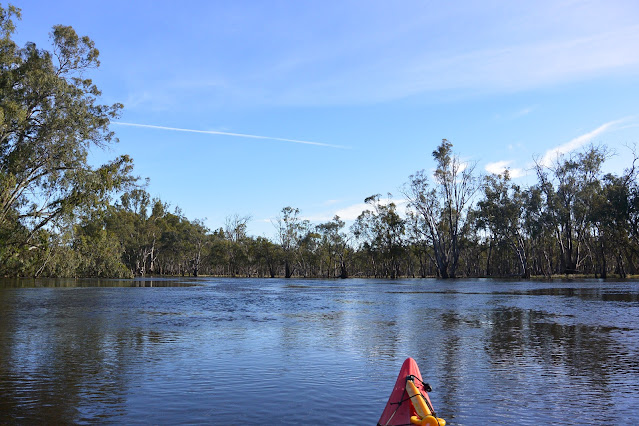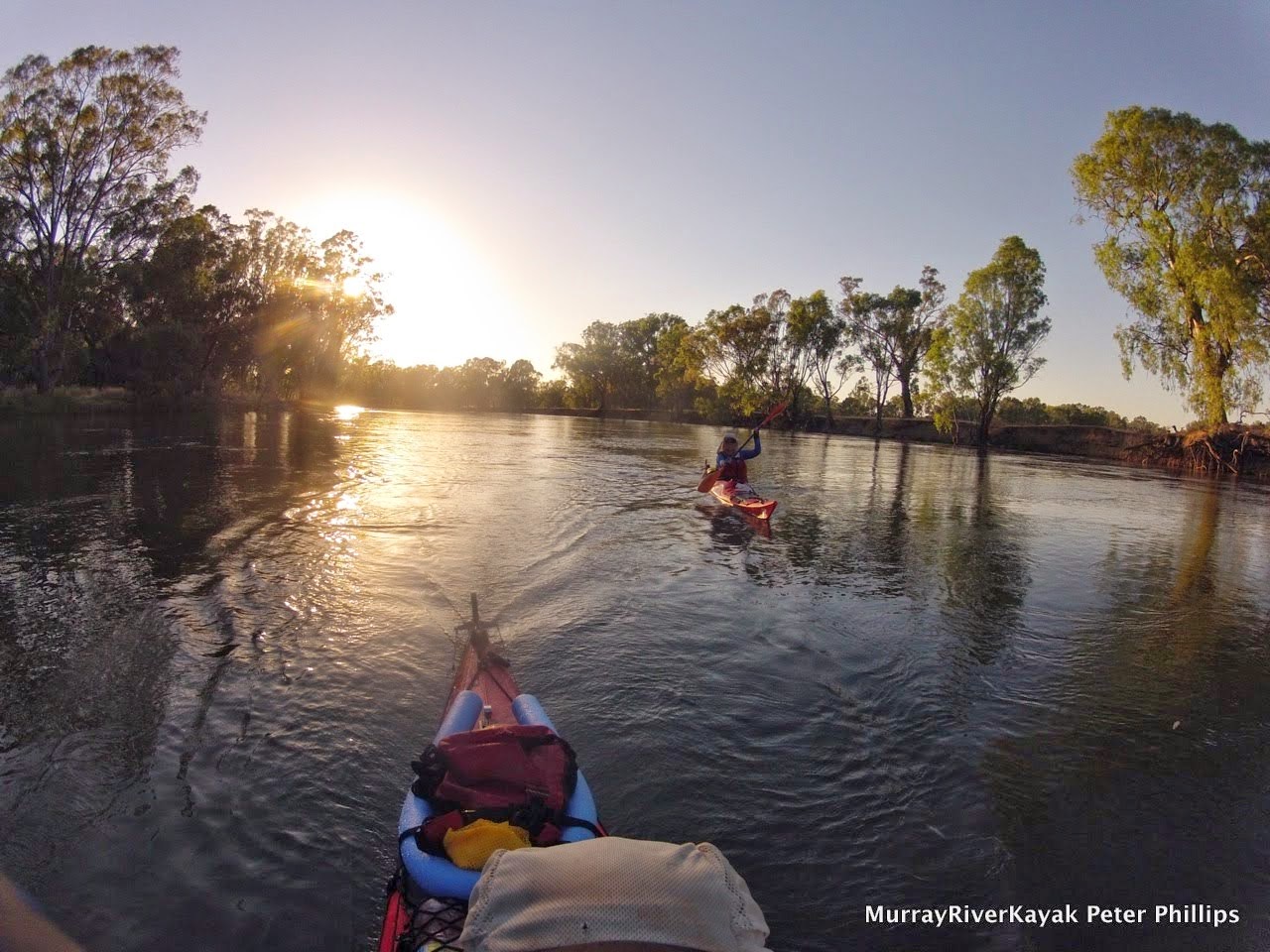Monday 13 Jan
Starting point 4 km from Howlong, at 2124, not far from Kismet Caravan Park.
Finish point 12km downstream of Corowa at Stanton Bend 2070km.
We had a disturbed night. At about 1am there was crash, disturbingly close to our tent. On further investigation, we found that a 4 m long branch had fallen from a young redgum adjacent to our tent. It missed us, but not by much, instead it landed flat across the front of our boats. Thank god they are not made of fibreglass. We could not find a mark. Gopro and all other equipment fine. We had been careful with our tent site, but the fall was disturbingly close, all the more so because it was from a young tree and in the middle of a near vertical branch. In addition it happened in a time of absolute wind still. Needless to say, our antennas will be even more sensitive in future.
 |
| http://www.murrayriver.com.au/about-the-murray/river-red-gums/ |
|
Parks Victoria advice on camping around Redgums. According to some research, mature trees are the most likely to drop branches. The most common branch size dropped is between 10 and 30cm in diameter, and that only 25% of tree drop their branches. Those that have dropped branches in the past are likely to drop them in the future. Location also has an effect, the following study found that if a tree drops its branches in a particular location, other trees in that location are also likely to drop their branches.
 |
http://parkweb.vic.gov.au/park-management/fire,-flood-and-other-closures/tree-risk |
|
I have noticed that trees in saturated ground topple easily, no matter how large. Along beaches, root systems are flat and unable to penetrate the soil further than the water level. These are easily blown over in the wind.
An Adelaide tree surgery report suggests that limbs fall because of minor structural flaws, such a cracks on limbs that reach above the canopy and are thus exposed to more wind than the rest of the surrounding trees, limbs that extend horizontally rather than vertically, branches which do not taper, but remain the same diameter, or those that have been damaged and include hollows.
University of California
Professor Richard W. Harris found that high humidity in the tree canopy and a reduced flow of water in the xylem (i.e. the wood) caused a build-up of pressure weakening cell wall strength. He found that breakages usually happen between 1 and 4m from where branches join the trunk.
Locally, limbs seem to fall just as much during the night as during the day. Perhaps changes in humidity have something to do with it. Hot days and the nights following them are known risks - so take care.
After that luck escape... and a few hours sleep... finally, we were on our way.
 |
| Early morning departure to beat the heat. |
 |
| It is nice to be able to share the journey. |
We did not sleep well for a couple of hours after that incident. Not surprisingly, when we got up at 5:30 for our planned early start to beat the heat, we were still quite tired. The early morning light was beautiful.
 |
| Cockatoos |
 |
| Every tree is an individual in its own way. each has its story, a reason for being the way it is, a reason why it has been able to withstand the floods and droughts which are inevitable on the Murray. |
Our first stop was 'cow beach' downstream from McVean Island at about 2108. Cow beach because of its friendly inhabitants. Whilst we rested, a large group of cows decided it was time for a drink. Once in our boats a few curious individuals needed to find out more and had a sniff, first of Ruth's spray deck and then the front of my boat. The cow that sniffed my boat turned out to be her mum, she brought her calf along a minute or so later. I almost fell out of my boat laughing. I have never thought of cows as cute before, but these definitely were.
Years ago on a round Australia trip, we came across a man sitting on the side of the road in a deck chair. We were driving from Darwin to Cairns and were looking for a place to spend the night. Company is good in that part of the world, so we decided to pull up near this man and his caravan. After settling in, we wandered over to say hello, to find the man now leaning on the barbed wire fence alongside the road, binoculars in hand. He had been there most of the day. He was a retired farmer, he told us, and he missed his cows. It is funny the things that you learn in a trip down the Murray. I felt that now, so many years later, I finally understood this man.
 |
| Cow lick beach. |
 |
| Curious cow. |
From there we made our way to Corowa, practising our cooling down technique for the four days where over 40 degrees celsius is predicted from tomorrow. This involved wetting ourselves down regularly, a break every 10km, and best of all, floating with the boats for a hour in the hottest part of the day. After the float we did some synchronised paddling, in time and only a meter and a half apart. We listened to music from my iPhone as we paddled the last 8 km into camp at Stanton's bend. These last two things were the highlights of my day. Loved sharing them with ruth. Wonderful experiences.
 |
| Refreshing milkshakes - worth the walk into town. |
 |
| Corowa's historic bridge. The 1892 John Foord bridge in Corowa is the only iron lattice bridge on the Murray river. It was the fourth bridge built across the Murray and established Corowa as a centre of commerce. It is the only bridge named across the Murray named after a pioneer settler. Though a second bridge has been built, it is such a part of the heritage and identity of the town that it is still in action. it is also the shortest way a very popular fish and chip shop across the river in Wahgunyah. |
 |
| Floating 4 km in the heat of the day: refreshing and fun. |
 |
| Evening swim at our campsite at Stanton Beach, 12 km downstream of Corowa. |

























































